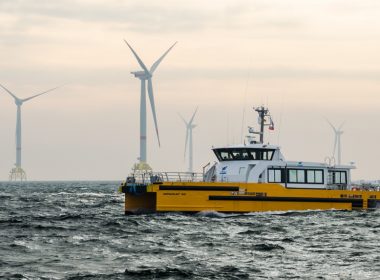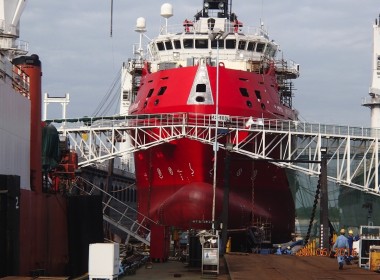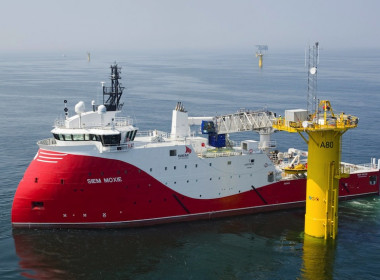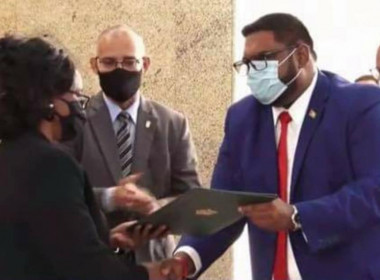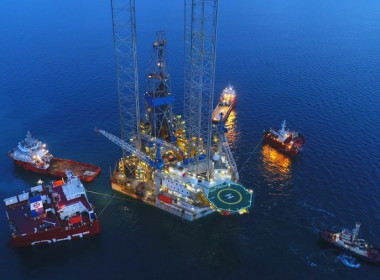COLUMN | The first twelve days of Christmas 2022: Sonangol, PwC and Isabel dos Santos; Windcat, Damen and CMB; LNG in East Timor, Mozambique and Tanzania [Offshore Accounts]

On the first day of Christmas my true love gave to me… a partridge in a pear tree, according to the ancient English carol, but at Baird Maritime, that’s the cue for a dozen topical features on the offshore industry.
Lovers of yuletide traditions – and even those of you who are mildly observant – will note that it’s now December, so, for the third year in a row, we’ll be running through the Twelve Days of Christmas, but from a maritime perspective.
On the first day of Christmas my true love gave to me… an arrest warrant?! Oh no!
Angolan partridge gets arrest warrant in her pear tree
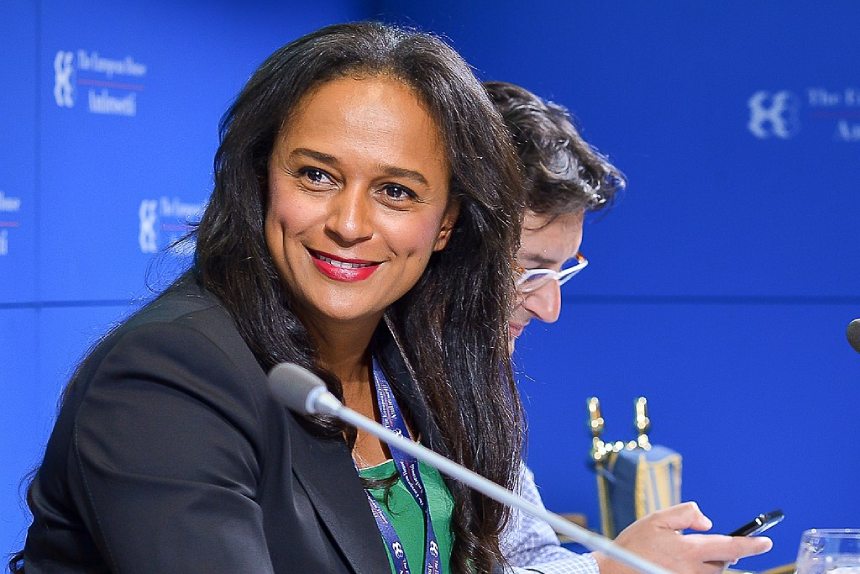
Red is a festive Christmas colour, the colour of Santa Claus’ robes, tinsel, and numerous scarlet baubles. Red is also the colour of the Interpol arrest notice issued last week against Isabel Dos Santos for alleged embezzlement, fraud, influence peddling and money laundering.
Ms dos Santos is the 49-year-old daughter of the deceased Angolan president, Jose Eduardo Dos Santos, who died in July (See our obituary here.). Ms dos Santos was formerly Africa’s richest woman, having amassed unprecedented wealth during the nearly forty years that her father ruled Angola before he stepped down in 2017.
In October 2020, her husband, the Congolese businessman and art collector Sindika Dokolo, had also died in a diving accident off the United Arab Emirates. That death came just months after her wealth manager, and the account manager for Angolan state oil company Sonangol at Eurobic bank, Nuno Ribeiro da Cunha had also been found dead from suicide in the garage at his home in Lisbon. Mr Ribeiro da Cunha had been accused of alleged mismanagement and misappropriation of funds whilst his client Ms dos Santos was chairwoman of the state oil firm from 2016 to 2017. She also controlled 41 per cent of the shares in Eurobic, El Confidencial claimed (here).
Dirty money had dirty helpers in Europe
In January 2020, Isabel’s half-brother, José Filomeno dos Santos, had been sentenced to five years in prison in Luanda for fraud, money laundering, and trading in influence after he was caught transferring hundreds of millions of dollars out of the country just days before his father resigned from office.
Now the net is tightening on Isabel herself. She was the subject of the International Consortium of Investigative Journalists’ (ICIJ) 2020 Luanda Leaks investigation (here). The Luanda Leaks showed how “insider deals, political connections, and an army of Western enablers” helped Isabel dos Santos amass billions in assets.
Accounting firm and tax consultancy PwC was named and shamed by ICIJ as playing a major role in the dos Santos empire, acting as auditor to companies linked to dos Santos and Mr Dokolo across Malta, Switzerland, and the Netherlands. From 2010 to 2016, the Boston Consulting Group also invoiced around US$4.3 million to companies owned or partly owned by Ms dos Santos and her husband, ICIJ found, including a Swiss jewellery company called de Grisogono, which threw lavish parties at the Cannes Film Festival, and lost close to US$200 million of Angolan state funds.
Last year, an international tribunal in the Netherlands ruled that Ms dos Santos must surrender one of her last remaining major assets, shares in the Portuguese energy company Galp, which the ICIJ estimated were worth US$500 million (here).
Sanctions alert! OFAC… Oh Feck (again)
Since her father left office, Ms dos Santos seems to have spent her time between Dubai, London, and Lisbon, complaining on social media that his successor is corrupt and incompetent, whilst avoiding Angola and side-stepping claims that her wealth comes from the proceeds of crime.
One country she can’t visit is the United States, however, as a year ago, on International Anti-Corruption Day, the US Department of State sanctioned the Angolan national for her involvement in “significant corruption by misappropriating public funds for her personal benefit” (here). Ms dos Santos and her immediate family are now barred from entering the country, along with General Leopoldino Fragoso do Nascimento and General Manuel Hélder Vieira Dias Júnior, cronies of her father who were sanctioned by the Office of Foreign Assets Control (OFAC).
Ms dos Santos has close to 175,000 followers on Twitter (here) and four hundred thousand followers on Instagram (here), where she posts frequent pictures of her favourite subject: herself. Now she faces her mugshot appearing on law enforcement websites and at immigration counters worldwide.
Merry Christmas, Isabel!
On the second day of Christmas, Windcat orders two turtle doves the first two-hydrogen powered CSOVs, ever!
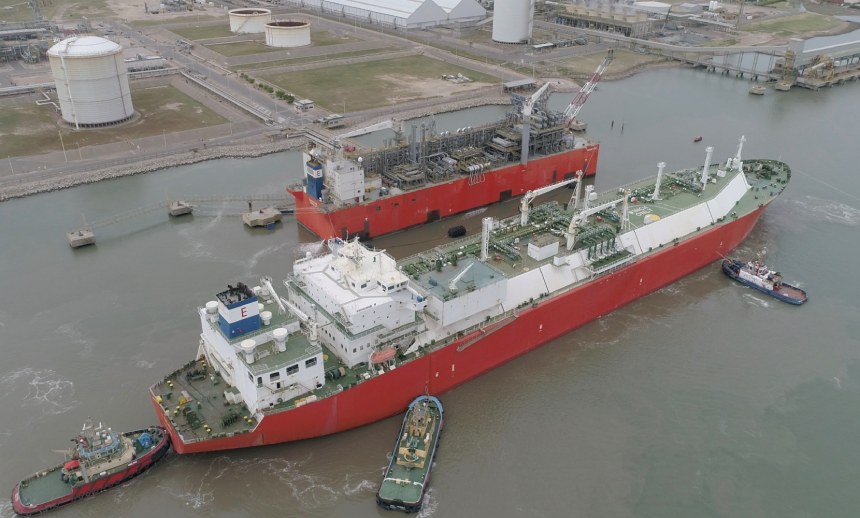
The year 2022 was a transformational one for Belgium’s wealthy Saverys family. Despite finally holding an 18 per cent stake in tanker owner Euronav, the family lost a bruising battle for control of the company, which is now on course to merge with John Fredriksen’s Frontline next year when regulatory approval has been received, after the boards of both companies approved the deal and the other shareholders rejected the Saverys’ efforts to appoint their own slate of directors (here). The merger would create a new company with 146 tankers and ten per cent of the world’s very-large crude carriers, a combined fleet able to transport up to 225 million barrels of oil.
The family also controls 45 per cent of Exmar, the liquefied natural gas (LNG) shipper. Nicolas Saverys is the chair of Exmar, whilst his son Carl-Antoine is an executive director, and his daughter, the saddle-seller Stephanie Saverys, is a non-executive director.
This year Exmar closed the sale of the floating liquefaction barge Tango Floating Liquified Natural Gas (FLNG) to ENI for operations inshore Republic of Congo for close to US$700 million, and also signed a ten-year charter agreement with ENI for the Exmar LNG carrier Excalibur to work on the same project. After the receipt of the proceeds of the sale of the Tango FLNG at end of August 2022, Exmar became net debt free, and in August it began to receive charter hire from the floating regasification unit it has contracted in the Netherlands to import LNG at Eemshaven. So, it is fair to say that the Saverys family is now cashed up.
But the biggest transformation is the Saverys family’s commitment to hydrogen as the fuel of the future. The Saverys family companies now lead the world in hydrogen-powered vessels.
Harbour tugs and crewboats
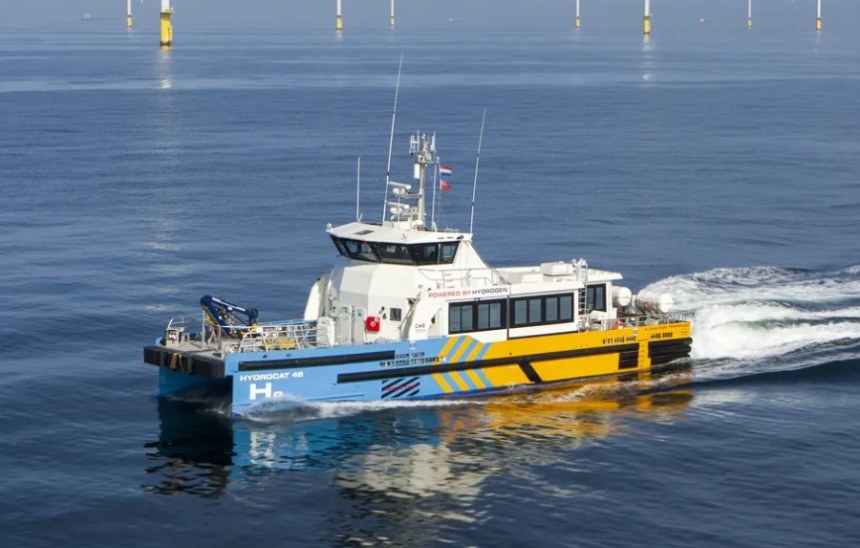
Last week, we reported that a new hydrogen-fuelled tug owned by the Saverys family’s CMB company had arrived at the Port of Ostend in Belgium to allow installation and testing of its hydrogen propulsion system. Built by Armon Shipyard in Spain to a design by the family’s CMB.Tech company, Hydrotug 1 will serve the Port of Antwerp-Bruges once it becomes fully operational in the first quarter of 2023. Hydrotug 1 can store 415 kilos of compressed hydrogen in six stillages installed on deck, which CMB.Tech says “eliminates the emission’s equivalent of 350 cars.”
Almost exactly two years ago, we featured the purchase of North Sea windfarm crewboat operator Windcat from Seacor by the Saverys family’s CMB in our inaugural Twelve Days of Christmas (here). CMB paid £32.8 million (then worth about US$45 million) in cash and assumed around US$26 million of Windcat’s debts.
Windcat owns and operates a fleet of over forty crewboats in the European offshore wind sector, and under CMB’s ownership committed to creating the first hydrogen powered crewboat, assisted by various UK government subsidies to facilitate the development of mobile bunkering, as we covered here. They kept their word and, this year, Windcat succeeding in delivering the world’s first hydrogen-powered crewboat, Hydrocat 48, placing it on charter with its first customer Vestas.
Full specifications are here and Baird Maritime’s review of the crewboat is here. The vessel is dual-fuelled with marine gas oil, but Windcat say that it receives daily hydrogen refuelling of 200 kilos, which saves 1.9 tonnes of carbon dioxide per day.
Seven hydrogen-powered crewboats
After the successful delivery of the inaugural crewboat, Windcat, together with its joint venture partners Thomas Services Maritimes and FSR, ordered an additional six hydrogen-powered crewboats, in September as per the press release from CMB.Tech here. The six additional hydrogen-powered crewboats include four vessels of the MK3.5H2 design, one of which will be delivered for the German offshore market and will be operated by the Windcat joint-venture FRS Windcat Offshore Logistics.
The other two vessels will be of the new MK5 series, a 27-metre-long crewboat with double the hydrogen capacity of the MK3.5H2 series, according to Windcat Workboats. CMB.TECH and Windcat Workboats said they are working together to further optimise engine capacities with the aim of increasing the percentage of hydrogen used in their dual-fuel design. Eventually, their aim is to develop the technology and infrastructure to create a mono-fuel, hydrogen-only vessel powered by an internal combustion engine.
We continue to admire the Saverys vision for a hydrogen-powered future for the maritime industry, their newbuilding tugs and crewboats, their research into engine applications and designs, and their investment in bunkering infrastructure in Belgium and overseas. We don’t know if it will succeed, but we even admire their chutzpah in getting British taxpayers to pay for half of the first mobile hydrogen bunkering station in the UK for Windcat.
Now they have launched an even bigger and bolder hydrogen-powered newbuilding order.
Damen to build hydrogen-hybrid CSOVs for Windcat
As we saw with Pelagic Partners, Edda Wind and GC Rieber last week (here), every windfarm commissioning service operations vessel (CSOV) claims to be the greenest, cleanest, and lowest emission vessel known to the human race.
But last week, Windcat moved ahead of the guff about being “ammonia fuel cell ready” by announcing an order for the construction of a series of hydrogen-powered CSOVs to be built with Damen Shipyards to a CMB.Tech design. The result is what Windcat says is a “revolutionary new design with increased capabilities and flexibility compared to existing vessels.”
The Windcat Elevation series of vessels are 87 metres long, 20 metres wide, and can accommodate 120 people on board. They will be hydrogen-dual fuel vessels. The first two vessels will be delivered from 2025 onwards from Damen’s Song Cam Shipyard in Vietnam, and Windcat has options for additional Elevation vessels as well.
It’s a game changer, and a reminder that Europe can be a technology leader in marine.
Three new LNG plants progress
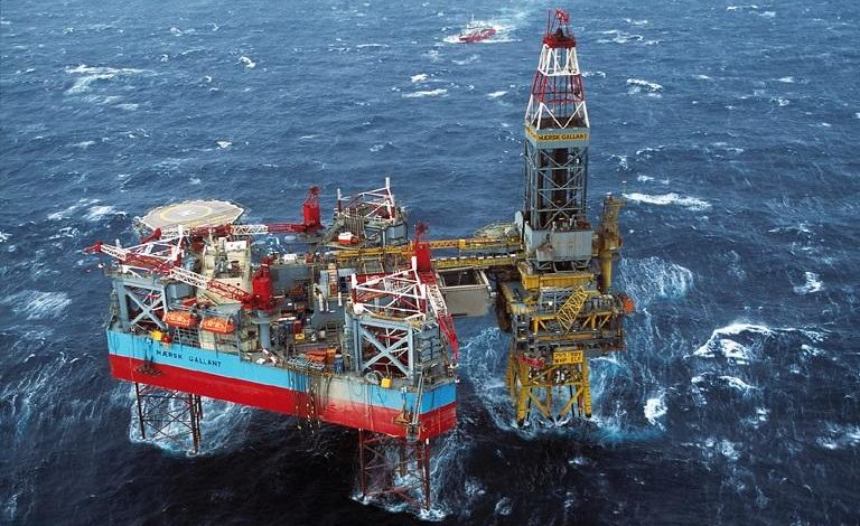
There’s never been a better time to build an LNG plant. Europe is hungry for energy, the Nordstream 2 pipeline has been blown up on the Baltic seabed by parties unknown, and Vladimir Putin continues his bloody and illegal invasion of Ukraine, making alternative supplies of gas a strategic imperative for both Britain and the European Union. We highlighted in April (here) that Europe has a Russian gas problem, whilst Russia has a dictator problem.
As a result, we see a rush to bring new gas projects to development. We saw above that ENI has chartered two floating liquefication units from Exmar for its project in the Republic of Congo. New Fortress Energy is providing ENI with the production facilities for the project, its “Fast LNG” facility, which will produce up to 1.4 million tonnes per year of LNG from ENI’s associated gas fields. New Fortress is using the two former Maersk Drilling rigs Maersk Guardian and Maersk Gallant as the production platforms. The rigs were bought out of lay-up for a total price of US$31 million in 2021.
Three long-awaited new LNG projects in frontier areas now stand on the cusp of investment approval.
East Timor and Woodside – At last the sun rises on Sunrise?
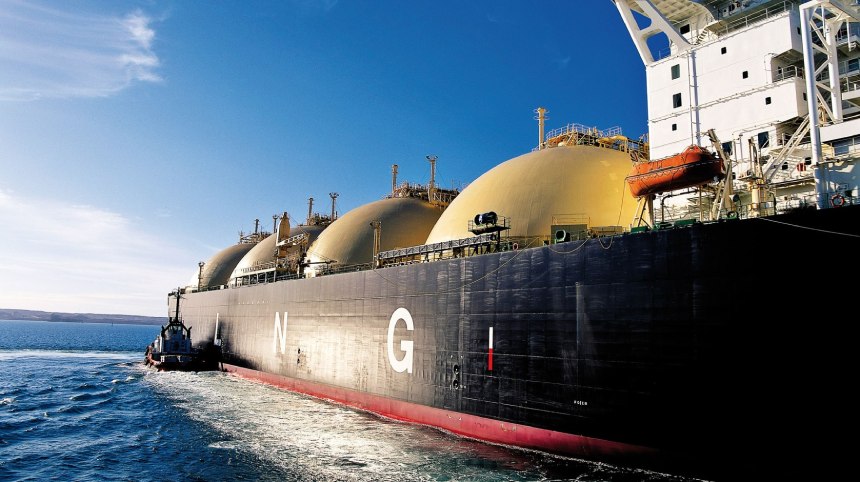
In 1974, Woodside drilled off what was then the Portuguese colony of East Timor and discovered the Troubadour and Sunrise oil and gas fields. Woodside tested the Troubadour-1 well and drilled additional wells at Sunrise in 1975.
Then nothing happened. Nearly fifty years on, the Greater Sunrise gas field remains undeveloped.
Actually, lots has happened, and that’s the problem. In 1975, Indonesia invaded East Timor. In 1989, Australia and Indonesia signed the Timor Gap Treaty, which established a Zone of Cooperation and provided for Indonesia and Australia to conduct joint exploration of the illegally occupied territory, with revenues shared 50/50. The treaty was ratified and took effect in February 1991. In August 1995, Woodside began to appraise Sunrise, and drilled seven appraisal wells by 1998. Sunrise holds 5.3 trillion cubic feet (150 billion cubic metres) of gas and 226 million barrels of condensate.
But the Asian crisis struck Indonesia hard in 1997, and its dictatorial president Suharto was toppled from power amid an economic crisis and rioting in 1998. His successor President B. J. Habibie agreed to hold a referendum on independence for East Timor in 1999. The people rejected Indonesian rule. After fighting and intervention from a UN-sponsored peacekeeping force, the small country finally became independent in 2001. So, Sunrise can progress, surely?
Meg O’Neill wakes up to technology
Its government then spent twenty years arguing with Woodside and the Australian government on how to develop Sunrise.
Last week, Woodside’s CEO said for the first time that it was willing to consider sending gas from Greater Sunrise to East Timor, instead of its long-preferred option of Darwin in Australia, or producing the via FLNG, which the government in Dili had rejected.
CEO Meg O’Neill said last Thursday, December 1, that new technology is available, including modular LNG like Fortress Energy’s systems, which did not exist when past concepts were evaluated.
FFS! If ENI can fast track LNG production in Congo of all places, Woodside should be able to manage it in East Timor, if it really puts the finest minds in Perth to it. As Juice Media reminds us, in this not suitable for work video, if Woodside spent as much effort on developing Sunrise as it did lobbying the Western Australian and federal governments, the project would already be in production.
Others are moving faster.
Mozambique – second floating LNG?
Last month ENI achieved the first LNG exports from the Coral Sul FLNG vessel in deepwater Mozambique (here). The success of Coral Sul only five years after project approval highlights not only the failure of Sunrise but also the failure of Total and ExxonMobil to develop the rest of Mozambique’s deepwater gas discoveries.
TotalEnergies suspended development of its LNG train onshore more than 18 months ago after an Islamic guerrilla attack on the towns of Palma and Mocimboa da Praia that killed dozens of people, including some of Total’s contractors. The March 2021 Al-Shabab insurgent attacks were just ten kilometres away from the construction site of Total’s US$20 billion LNG plant on the Afungi peninsula. The project remains postponed and under force majeure until today.
Do you trust Mozambican President Filipe Nyusi?
In September, Mozambican President Filipe Nyusi assured foreign investors that the security situation in troubled northern Cabo Delgado Province had improved, and urged Total to return and restart the construction of the LNG plant and associated jetties and infrastructure. Unfortunately, that same month, insurgent attacks spread to Mozambique’s northern Nampula Province, where Al Shabab forces attacked several villages, beheaded six Mozambicans, killed an Italian nun, abducted three people, and torched scores of homes.
The attacks make the idea of additional floating LNG production even more attractive. Zitamar News is hosting a webcast on the Cabl Delgado security situation on December 7 for those interested for an update (here). Given that five local government militia were beheaded by the Islamists in Nampula in the last week of November, security onshore clearly remains fragile.
But the success of Coral Sul has prompted ENI and its partner ExxonMobil to evaluate either a second deepwater FLNG unit, or a subsea scheme to liquefy the gas in a similar nearshore scheme to the one ENI is developing in Congo. Upstream reported here that Technip Energies and Samsung Heavy Industries, which built and installed the Coral Sul FLNG, are in dialogue with ExxonMobil about fabricating a second sister FLNG vessel for the Coral North gas field.
High gas prices, Europe’s pressing need for new sources of supply, and the increasingly wide adoption of FLNG make a Coral North development with FLNG a viable prospect for approval in 2023. Watch this space.
Tanzania – Shell and Equinor move ahead
North of Coral North, over the border but in the same geological formations, Shell and Equinor are progressing the Tanzania LNG project. In June, the two companies signed a framework deal in Dodoma with the Tanzanian government as the next step towards finalising a host government agreement (HGA).
“It’s happening,” Tanzania’s Energy Minister, January Makamba, told Bloomberg (here) in an interview in Sharm el-Sheikh, Egypt, at the COP27 international climate summit last month. “In December, we will conclude the conversation. We are in the fiscal package discussions now.”
Signing the HGA with Equinor and Shell will put in place the legal and contractual framework for the US$40 billion LNG export project, with a shore-based plant to be built at Lindi.
The first deepwater gas discoveries off Tanzania were drilled close to the border with Mozambique more than a decade ago by BG, which was subsequently bought by Shell. The development of the LNG plant was put on hold by John Magufuli, who was Tanzania’s erratic head of state until his death from Covid-19 in 2021. His successor President Samia Hassan was much more in favour of the development as a driver for national prosperity and made it a priority for Mr Makamba to fast-track negotiations with Shell and Equinor.
The project aims to pipe some 40 trillion cubic feet (1.1 trillion cubic metres) of gas from deepwater blocks 1, 2 and 4 to Lindi, where the liquefication plant will produce 10 million tonnes per year of LNG plant. President Hassan expects that a final investment decision could be taken in 2025, with first LNG shipped in 2030.
That’s a whole lotter better than Three French Hens as per the original carol, I think you can agree. These projects will underpin years of work for rigs and offshore support vessels (OSVs) when they proceed.
Join us next week as we move ahead to six geese a-laying, five golden rings, four calling birds, etc. What will they be? Will you and your company get a mention?
Background Reading
Our 2020 Twelve Days of Christmas featured some classics, which have stood the test of time nicely (here and here) covering Cairn Energy (as was), Esvagt, Vantage Drilling, Shearwater, Swire Pacific Offshore and Seacor, followed by the oil price, floating wind, ammonia fuel cells, Myanmar, Bourbon and Standard Drilling (as was).
Our 2021 Twelve Days of Christmas (here, here and here) featured Cairn Energy becoming Capricorn Energy, Vantage Drilling, North Star and Vard, Shearwater and Shell, Windcat Workboats, Swire Pacific Offshore, ammonia fuel cells, the oil price, Myanmar, Floating Wind again, Bourbon’s revival and Standard Drilling (as was).
The slow and painful history of Sunrise and East Timor’s troubled relations with Australia and Indonesia is here.


